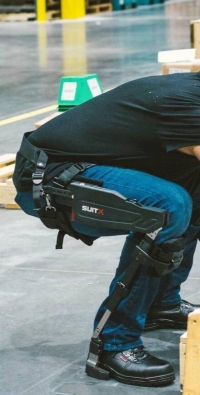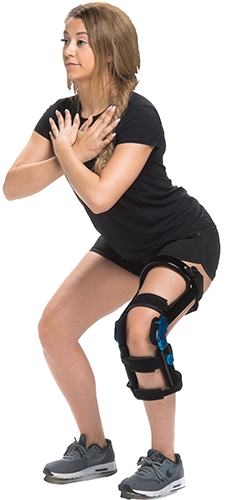Knee Support Brace – What You Need to Know
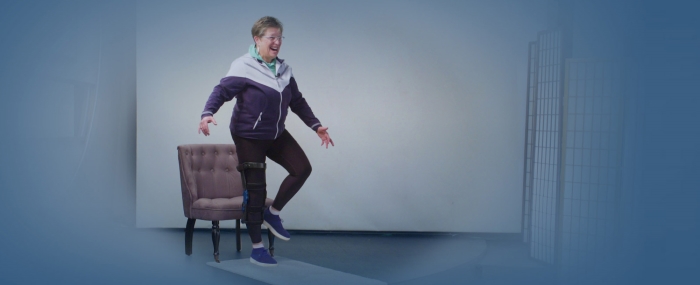
When the knee joint is damaged, it can benefit from the support and stability provided by a knee brace. Knee support braces come in many shapes and sizes. Although they might work in different ways, the basic purpose of a brace is to help relieve pain and protect your knee from re-injury. The best knee support braces can also improve joint function and mobility, allowing you to return to your favourite activities. In this article, we’ll cover the different types of knee support brace and give some tips on how to choose the right brace for your situation.
Why Wear a Knee Support Brace?
You might wear a knee support brace for one or more of the following reasons:
Injury Prevention
Athletes who play contact sports (e.g. football) are very susceptible to knee injuries caused by sudden contact or twisting. A type of knee support brace called a prophylactic brace can help protect the knee from potential damage.
Injury Recovery
The knee can benefit from extra support while recovering from an injury like a ligament or meniscus tear, dislocation, or tendon injury. A knee support brace can take the strain off of the damaged part of the joint so it can heal effectively. Braces can also help ensure you don’t re-injure your knee when first returning to activity.
Pain Relief
Many people struggle with chronic knee pain caused by degenerative conditions like arthritis. A knee support brace helps to reduce pressure on the knee, which can relieve pain in these situations. This can allow you to stay active and delay or avoid knee replacement surgery.
Surgery Rehabilitation
After knee surgery, the knee is vulnerable and needs time to heal. Sometimes the joint needs to be protected by a knee brace for a period of time post-surgery. Returning to weight-bearing activity and exercise is a gradual process. A knee brace can help support you during rehabilitation to help ensure a positive outcome.
Mobility Assistance
Individuals who have a neuromuscular disease (e.g. muscular dystrophy) often experience mobility issues that make daily activities like walking difficult. Certain types of knee brace may be able to provide enough support to help regain some function and mobility in some cases. For more severe cases, a powered exoskeleton device might be more useful.
Knee Support Brace vs Exoskeleton
You might come across knee exoskeletons when searching for a knee support brace. Knee exoskeletons are devices designed to support the knee and enhance or assist leg movement. They are often powered by batteries or motors, which allow them to support most of the user’s body weight and initiate movement. As a result, they are most helpful for rehabilitation from neuromuscular diseases, spinal cord or brain injuries, strokes, or other conditions that severely impair motor function and mobility. In these cases, one may not have enough muscular control to move or support their weight, so the energy and support for movement comes from the exoskeleton. Some exoskeletons are used by the military to enhance performance and reduce fatigue, or workers in industrial settings that put a lot of stress on their knees.
In contrast, knee support braces are not powered by motors or batteries. Your muscles provide the energy for movement, while the brace works to support and stabilize your knee joint. Compared to exoskeletons, knee braces tend to be much smaller and lighter. This makes them better suited for exercise and athletics. Knee braces are also more cost-effective than exoskeletons, making them more accessible to the general public. An exoskeleton is probably only worth looking at if you have seriously impaired motor function or mobility due to an injury or disease. A knee support brace is more practical in most situations and better for day to day use.
Different Types of Knee Support
Knee support braces come in many shapes and sizes, each functioning in a unique way to support your joint. Below are the various types of support a brace can provide, plus examples of different braces.
Compression
Compressing the knee joint can help improve stability, balance, and proprioception, while also providing warmth to increase blood flow.1 This can help reduce pain and stiffness in the joint. For those with osteoarthritis, another benefit of compression is decreased joint load, which helps to relieve symptoms.1 To learn all about compression knee braces, check out this article.
Examples of Compression Braces
- Knee sleeve: Made of elastic or neoprene material, a sleeve compresses the entire knee joint to provide the benefits listed above.
- Knee strap: Compresses a specific point on a tendon. This changes the tendon’s length and insertion angle, which reduces strain on the injured area during activity to relieve pain.2,3
Both knee sleeves and straps are cost-effective, lightweight, and flexible. This makes them great to use during sports and exercise, but also means that they provide less support than hinged knee braces. Other types of braces (e.g. functional braces) can also provide some degree of compression in addition to their other capabilities.
Stabilization
A common symptom of many knee injuries is instability, so an important function of many knee support braces is to restore stability to the joint. This helps to improve function, protect against re-injury, and ensure a safe return to exercise.
Examples of Stabilizer Braces
- Patellar stabilizer: Stabilizes the patella (knee cap) to correct alignment and tracking in the femoral groove. They can be effective as a complementary treatment to relieve patellofemoral pain syndrome.4-6
- Functional brace: Helps stabilize the knee following ligament injuries or surgery. They provide more support than compression sleeves and straps, but are also heavier and bulkier.
Range of Motion (ROM) Control
Depending on the injury, certain movements put the knee at risk for further damage or re-injury. Some knee support braces restrict your range of motion (e.g. the extent that you can bend or straighten your knee) so you don’t accidentally put your knee in a vulnerable position. This also might be required post-surgery.
Examples of Braces That Control ROM
- Functional brace: Some functional braces also help control range of motion to reduce unwanted forces on damaged ligaments. For example, an ACL brace can prevent twisting and hyperextension, while a PCL brace can limit backwards movement of your shin bone.7
- Rehabilitative brace: Similar to a functional brace, it restricts movement to protect the knee while recovering from surgery.
Joint Offloading
Offloading the knee is useful for treating osteoarthritis because it reduces pressure on the damaged joint surfaces that are causing your pain. One type of knee support brace, called an offloader brace, is specifically designed for this purpose. Offloading can also help take pressure off of an injured meniscus.
Examples of Offloader Braces
- Uni-compartment offloader: Shifts pressure away from the damaged and painful side (compartment) of your knee so that the healthy side absorbs most of the force. This type of offloader is useful if you have osteoarthritis in only one side of your knee.

- Tri-compartment offloader: Reduces pressure in all three compartments of your knee (including under the knee cap) to relieve pain across the entire joint. This type of offloader can relieve pain and improve mobility if you have osteoarthritis in multiple parts of your knee or under your knee cap.

You can read more about some of the best offloader braces here.
Knee Extension Assist
Some knee support braces have the ability to assist your leg muscles as you straighten your knee. This can help improve muscular strength and control. It also might help you stay active for longer and avoid muscle fatigue. Developing stronger muscles provides natural support for your knee, reducing your dependence on a brace.
Examples of Knee Extension Assist Braces
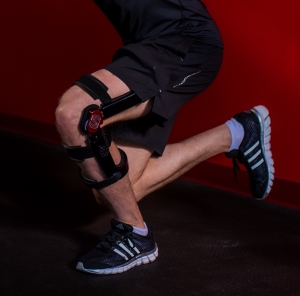
- Tri-compartment offloader: In addition to offloading the entire knee joint, this type of support brace can also assist knee extension. Using a powerful bionic hinge, it absorbs body weight when you bend your knee, then releases that energy to power your muscles as you straighten your leg.
What’s the Best Knee Support Brace?
It depends on how much support you need. For less severe injuries, a knee sleeve, knee strap, or stabilizer may provide enough support. For more severe injuries, a functional or rehabilitative brace may be required, followed by a knee sleeve in the later stages of recovery. The support of an offloader brace is most beneficial for those with moderate to severe osteoarthritis. Among offloader braces, a tri-compartment offloader provides the most support.
The best knee support brace also depends on what type of support you need. Most types of knee support braces are designed to provide stability for the joint, and many also provide some form of compression. Functional and rehabilitative braces are unique in that they can control your range of motion. This makes them especially useful for recovery from ligament injuries or surgery when range of motion may need to be limited to protect the joint.
While knee sleeves and uni-compartment offloaders can offload parts of the knee joint, a tri-compartment offloader is the only knee support brace that provides total joint offloading. It’s also one of the few braces that can assist knee extension. These two unique features make it one of the best bracing solutions for those with multicompartmental or patellofemoral OA. Tri-compartment offloaders are also effective for meniscus and ligament injuries and for general mobility assistance.
Levitation Tri-Compartment Offloader
Spring Loaded’s Levitation knee brace, the world’s first tri-compartment offloader, is the only knee support brace that can offload all three knee compartments at once and assist knee extension. This innovation in bracing technology combines some of the capability of a knee exoskeleton with the lightweight and compact design of a knee brace. It’s patented bionic hinge contains a liquid spring that absorbs body weight as you bend your leg. As you straighten your leg, the spring releases energy to assist your leg muscles. This can reduce joint forces across the entire knee by over 40%,8 which is equivalent to taking 45 lbs of body weight off of your joint.9
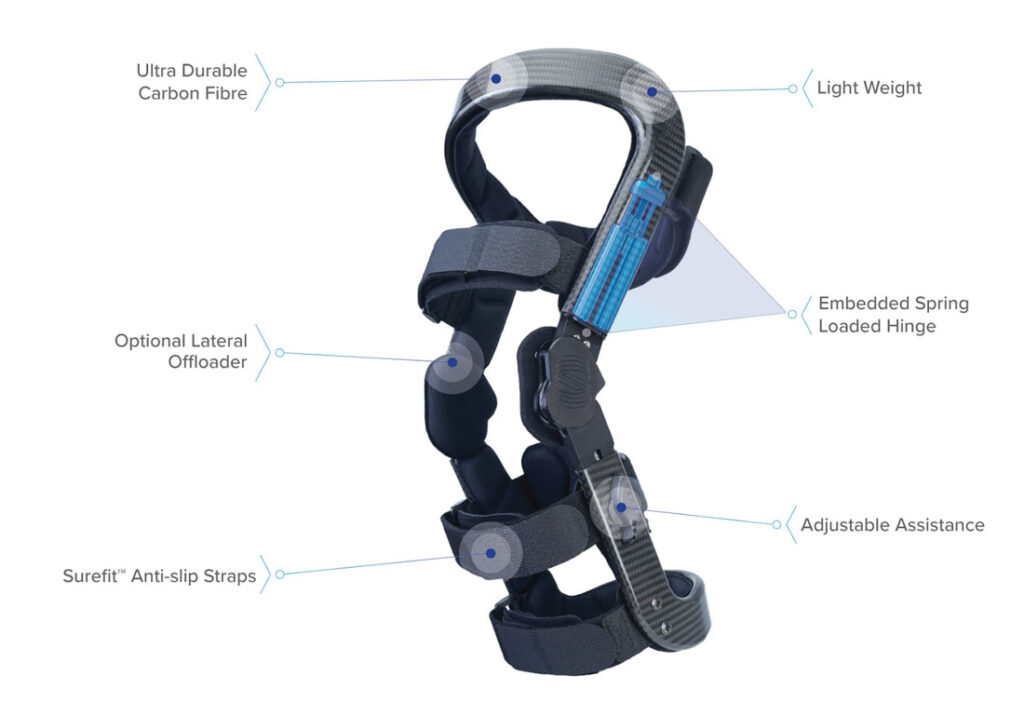
Levitation provides can provide support to help you overcome pain and mobility limitations caused by osteoarthritis, meniscus tears, ligament injuries, or other conditions. The added power it gives your leg muscles can help you stay active for longer while avoiding pain and fatigue.
Knee Support for Osteoarthritis
Levitation is one of the best knee support braces for those with osteoarthritis (OA). Since the brace can offload all three knee compartments, it can relieve pain from all patterns OA, regardless of which compartments are affected. Other braces may be able to offload one or two tibiofemoral compartments, but Levitation is the only brace that can also offload the patellofemoral compartment. Nearly all Levitation users with OA report significant improvements in pain and mobility.10 Many are able to enjoy more time exercising as a result.10 If you’re looking for a way to delay or avoid knee replacement surgery, Levitation may be the solution for you.
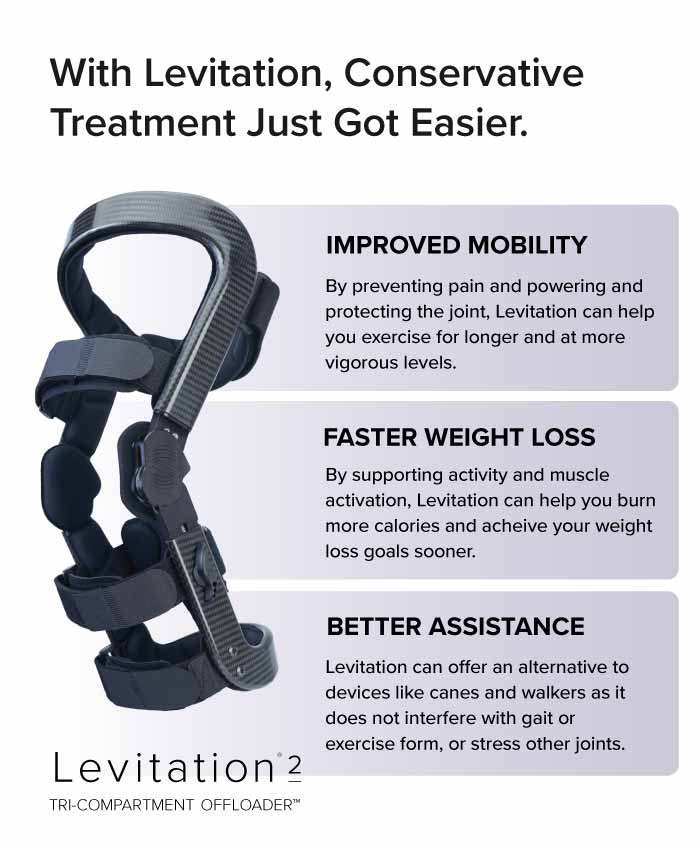
If you want to learn more about why Levitation is one of the best knee braces for OA, check out this resource – The Best Knee Brace for Osteoarthritis.
You can also find more information about Levitation on Spring Loaded’s website.
If you think you might benefit from wearing Levitation, feel free to book a free consultation with one of bracing specialists by clicking the button below.
References
- https://www.sciencedirect.com/science/article/abs/pii/S1466853X1730202X
- https://journals.sagepub.com/doi/abs/10.1177/1528083707072357
- https://www.ncbi.nlm.nih.gov/pmc/articles/PMC3445162/
- Dutton, R. A., Khadavi, M. J., & Fredericson, M. (2014). Update on Rehabilitation of Patellofemoral Pain. Current Sports Medicine Reports, 13(3), 172–178.
- Arazpour, M., Notarki, T. T., Salimi, A., Bani, M. A., Nabavi, H., & Hutchins, S. W. (2013). The effect of patellofemoral bracing on walking in individuals with patellofemoral pain syndrome. Prosthetics & Orthotics International, 37(6), 465–470.
- Petersen, W., Ellermann, A., Gösele-Koppenburg, A., Best, R., Rembitzki, I. V., Brüggemann, G.-P., & Liebau, C. (2014). Patellofemoral pain syndrome. Knee Surgery, Sports Traumatology, Arthroscopy, 22(10), 2264–2274.
- Welch T, Keller T, Maldonado R, et al. The effect of a dynamic PCL brace on patellofemoral compartment pressures in PCL-and PCL/PLC-deficient knees. J Exp Orthop 2017;4:10.
- McGibbon, C.A., Brandon, S., Bishop, E.L., Cowper-Smith, C.D., and Biden, E. (2020). Biomechanical study of a tricompartmental offloader brace for patellofemoral or multicompartment knee osteoarthritis. Frontiers in Bioengineering and Biotechnology, 8.
- Budarick, A.R., MacKeil, B. E., Fitzgerald, S., and Cowper-Smith, C.D. (2020). Design evaluation of a novel multicompartment offloader knee brace. Journal of Biomechanical Engineering, 142(1).
- Based on a retrospective survey of Spring Loaded brace users with knee osteoarthritis.
